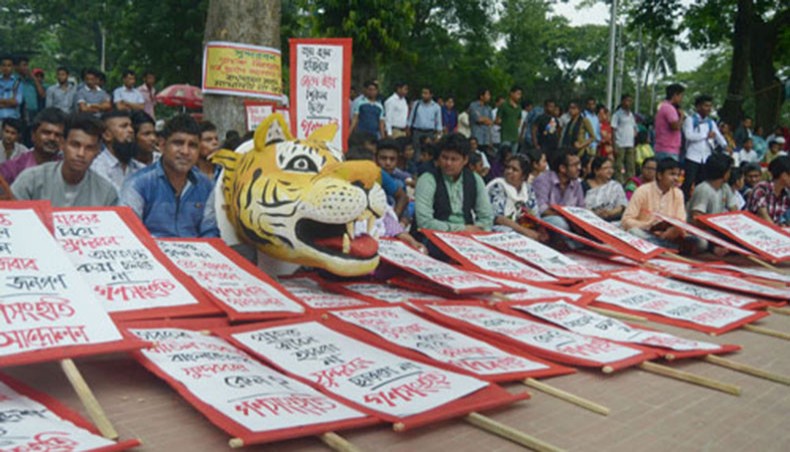Environmentalists from Asian countries have urged the government to refrain from any installation that will put in peril the fragile ecology of the Sunderbans, the world’s biggest mangrove forest and a World Heritage Site.
Expressing their concerns about the government’s plan to build a massive coal-fired power plant close to the Sunderbans, most of the environmentalists, government officials from India, Sri Lanka, the Maldives, Thailand, top regional representatives of The International Union for Conservation of Nature, Wetlands International, and Mangrove for the Future, while talking to New Age during a October 25-29 programme, also recommended relocation of the plant.
The experts, who came to the Bangladesh to join a steering committee meeting of Mangroves for the Future, a regional coastal initiative comprising 11 nations including Bangladesh, also said that let alone power plant, there should be no major development infrastructure near the Sunderbans which can affect the mangrove forest.
Terming Sunderbans’ ecosystem unique and citing its role as a safeguard against
extreme weather such cyclones, they have observed that coal-fired power station also is a heavy contributor to climate change, and Bangladesh is considered one of the world’s most vulnerable countries to impacts of climate change, including sea level rise, changes in weather patterns and more severe storms.
IUCN Asia regional director Aban Marker Kabraji told New Age that one of their missions came to Bangladesh that reviewed the site and proposal of the particular development.
‘The mission feels that if this development proposal goes ahead as it is proposed, there is real danger to the Sunderbans and its world heritage status,’ he said.
A joint team of experts from the UNESCO and the IUCN had prepared a report following a visit to Bangladesh in March 22-28. They recommended relocation of the power plant to a more suitable location.
In the report, the expert team identified some concerns related to the construction of the plant such as air pollution due to coal ash, pollution by wastewater and waste ash, increased shipping and dredging and the cumulative impact of industrial and related development infrastructure on the forest.
Mentioning the fragility of the Sunderbans ecology, the report has also expressed concerns that freshwater flow into the forest has drastically reduced, resulting in substantial increases in siltation and salinity threatening the overall balance of the ecosystem.
The report recommended the government’s immediate action to secure adequate freshwater flow to the Sunderbans.
‘I hope the government will make right decision heeding to the concerns,’ said Aban Marker Kabraji.
Mangrove for the Future coordinator Steen Christensen said, ‘The Sunderbans is a very vulnerable area and there are millions of people depending on it. So something done without proper precaution will of course involve risk factors.’
Conservation programme manager of Wetlands International – South Asia Ritesh Kumar said he was yet to see the details of power plant plan and observed that a balance between development and keeping environmental integrity was important.
Conservation of the Sunderbans should be given the highest priority because without the forest an entire population would be exposed to rising sea level and cyclones, he warned.
‘If it is affecting the Sunderbans, the power plant needs to be relocated. I don’t see any other option left as thermal power plant has a very high environmental footprint,’ he added.
According to Indian Bay of Bengal Programme director Yugraj Singh Yadava, the Sunderbans has a unique ecosystem and it is very important for both Bangladesh and India to ensure that the mangrove forest is protected.
‘Both the countries should also ensure that no industry, no infrastructure project and no major human intervention adversely impact the mangroves,’ he said.
‘Mangrove ecosystem is very fragile, it needing a very good balance of fresh and saline water, and if a major infrastructure is set up near the Sunderbans, it will have adverse impacts — pollution of air and water and changes in habitat,’ he apprehended.
The Rampal power station, a joint partnership between Indian National Thermal Power Corporation and Bangladesh Power Development Board, is a 1320 MW coal-fired power station in Bagerhat.
Ajith De Silva, a director of Sri Lanka’s environment and renewable energy ministry, said the whole South Asia was proud of the Sunderbans.
‘So, the government should take precaution that no damage is done to it,’ he said.
Echoing him, the Maldives government’s Environmental Protection Agency director general Ibrahim Ibrahim Naeem said, ‘We should do all our best to sustain the environment of the Sunderbans.’
‘The best option will be relocation of the plant, even if the budget increases,’ he said.
Environment and forests minister Anwar Hossain Manju said recently that the government was going to install the coal-fired Rampal power plant only to meet the demand for electricity amid opposition from almost the whole world.
‘It is a herculean job to keep the nature intact in a country like Bangladesh with 170 million people,’ he said
‘The largest mangrove forest of the world is situated in the southwest of the country having no resource of energy but wood,’ he bemoaned.
Source: New Age










